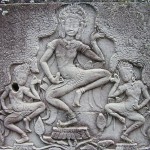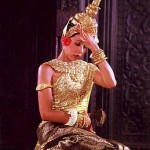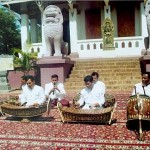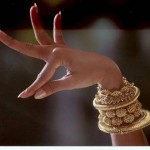People in Cambodia use dance to show the divine power, celebrate the social events, and create laughter in daily life. Cambodian dance can be divided into three different categories: Khmer Classical Dance, Folk Dance, and Vernacular Dance.
Khmer Classical Dance:
This form of dance is also known by a name in English called “Royal Ballet of Cambodia”, and it is listed in UNESCO’s Masterpieces of the Oral and Intangible Heritage of Humanity in 2008. This dance was performed only for royalty meaning the “dances of royal wealth”.
Khmer classical dance is believed to derive from Indian court dance, which traces its origins to the apsaras(see pic1) of Hindu mythology, heavenly female nymphs who were born to dance for the gods. The traditions of Thailand and Java (in Indonesia) also influenced the music and dance of Cambodia.
Over the history of Cambodia, role of Royal Palace’s dancers have become symbols of the King’s prestige. After the signing of the 1863 Protectorate Treaty, the French, who among many other things controlled the country’s finances, tried to reduce the number of palace dancers in order to lessen the King’s prestige. In the 1930s, the French subsidized the private troupe of Princess Wongat Say Sangvann, which performed for tourists, calling it the “one and only true” troupe. But after King Norodom Sihanouk acceded to the throne in 1941, his mother Queen Sisowath Kossamak found ways to reestablish the royal troupe’s ascendancy. In support of her son, Queen Kossamak transformed performances so that the royal troupe could best serve Cambodia’s image nationally and abroad. She shortened the length of the dance programs, had pure dance pieces followed by dramatic or comic works, and added musical interludes.
However, the tradition of dance, last for over a millennium, was almost lost in the Cambodian genocide, when the Khmer Rouge targeted those involved in the dance and “imposed a massive cultural forgetting”. Khmer classical dance suffered a huge blow during the Khmer Rouge regime when many dancers were killed because classical dance was thought as of an aristocratic institution. Although 90 percent of all Cambodian classical artists perished between 1975 and 1979 after the fall of the Khmer Rouge, those who did survive wandered out from hiding, found one another, and formed “colonies” in order to revive their sacred traditions.*
*(Reference: Earth in Flower – The Divine Mystery of the Cambodian Dance Drama by Paul Cravath)
Khmer classical dancers use silent movements and gestures to tell a story. Dancers do not speak or sing; they dance with a slight smile and never open their mouths.(see pic2) Khmer classical dance can be compared to French ballet in that it requires years of practice and stretching at a young age so the limbs become very flexible.
In classical Cambodian dance, women, dressed in brightly colored costumes with elaborate headdresses (also see pic2), perform slow, graceful movements accompanied by a percussive ensemble known as the pinpeat. Pinpeat orchestras include drums, gongs, and bamboo xylophones. (see pic3)
The way Khmer classical dance communicate with audience is very complicated. Different position of the arm and the position of the hand relative to the arm can also express different meaning. Besides hand gestures are gestures which are more specific to their meaning, such as that which is used to represent laughing or flying. These other gestures are performed in different manners depending on which type of character is played.
In addition to the renowned graceful hand gesture(see pic4) and stunning costumes, the Khmer Classical Dance, has been closely associated with the Khmer court for over one thousand years. Performances would traditionally accompany royal ceremonies and observances such as coronations, marriages, funerals or Khmer holidays. This art form is highly cherished by many Cambodians.
Infused with a sacred and symbolic role, the dance embodies the traditional values of refinement, respect and spirituality. Its repertory perpetuates the legends associated with the origins of the Khmer people. Consequently, Cambodians have long esteemed this tradition as the emblem of Khmer culture. Four distinct character types exist in the classical repertory: Neang (woman), Neayrong ( man), Yeak (giant), and Sva (monkey). Each possesses distinctive colours, costumes, makeup and masks. An orchestra accompanies the dance, and a female chorus provides a running commentary on the plot, highlighting the emotions mimed by the dancers, who were considered the kings’ messengers to the gods and to the ancestors.
Classical Cambodian Ballet: Apsara
Folk dance:
Folk dances play a role of performing art to entertain the audience. Khmer folk are fast-paced, and the movements and gestures are not as stylized as Khmer classical dance. Folk dances mostly are about love or the story about animals. The dancers wear costumes that portray ordinary people character, such as farmers, peasants, and tribe leaders. The elements of folk dance diversify profoundly by different area and local cultures. The most famous of all, Robam Trot, is mainly performed during the Cambodian New Year. The Dance got its history along a legend about a hunter and deer.
Vernacular dance:
In Cambodia, vernacular dance (or social dance) is the dance performed at social gatherings. Some of these dances are heavily influenced by the traditional dances of Laos. But rom kbach, for example, take heavily from the classical dance of the royal court. Rom kbach is a simple dance which uses hand gesture similar to that of classical dance and rom kbach song also utilize the melodies of classical dance songs and combine them with traditional Khmer and Western instruments.
Other social dances from around the world have had an impact on Cambodian social cultures include the Cha-Cha,Bolero, and the Madison. Such dances are often performed at Cambodian wedding receptions and banquets.
Yosuke and Tan-Chi





wetten unter freunden app
Also visit my page – buchmacher ohne steuer, Xavier,
quote online wetten Ohne ausweis
bedeutung
The 4 Star Hotels in Shimla by Bliss Hotels & Resorts promise a peaceful retreat surrounded by hills. Relax in beautifully designed rooms, enjoy fresh mountain air, and visit nearby attractions like The Mall and Jakhoo Temple. Perfect for families or couples, it’s your ideal home in the hills.
If you have time, please visit my site
토토사이트
Its an amazing website, I really enjoy reading your articles.
토토사이트 추천
I’d like to thank you for the efforts you have put in penning this website. 바카라사이트
Aw, this was an extremely nice post.
바카라사이트 추천
PT Propack Kreasi Mandiri yang berlokasi strategis di Cikarang – terdekat jantung kawasan industri Jababeka, fokus pada produksi packaging otomotif
This post beautifully captures the rich cultural heritage of Cambodian dance. The detailed insights and vibrant imagery truly bring the art form to life. Hi, I’m Kavitha. If you are looking for the best ISO consultants, visit our link for: ISO Certification Oman
In today’s fast-paced world, staying updated is essential. Breaking News on CNN brings you real-time updates from around the globe — covering business, technology, travel, and more. CNN’s reliable and accurate reporting ensures you’re always informed about what matters most. Whether it’s the latest innovation, an inspiring story, or a global event, you can trust CNN to deliver with integrity and clarity. Stay one step ahead — follow Breaking News on CNN and enjoy smart, timely journalism every day.
For many people in the United States and beyond, the rising cost of prescription medications has become a serious financial burden, pushing patients to look for safer and more affordable alternatives, and one of the most popular solutions in recent years has been turning to legit Mexican online pharmacy options that provide genuine medicines at a fraction of the cost compared to domestic pharmacies, all while ensuring safe, reliable, and discreet delivery to customers’ doors; however, before making a purchase from any pharmacy outside the U.S., it is crucial to understand how to identify whether the provider is truly legitimate, what benefits these options offer, and what precautions buyers should take to protect their health and finances.
Finding a cool way to improve your productivity can change your life. Set realistic goals, take short breaks, and explore inspiring stories on CaffeYolly to keep your motivation high. Our business and tech articles offer fresh insights that help you work smarter, not harder. Boosting productivity doesn’t have to be boring — sometimes, all it takes is the right mindset and a bit of inspiration. Now that’s truly a cool way to improve!
در نهایت، باید دانست که طراحی سایت فروشگاهی ارزان به معنی بیکیفیت نیست. اگر با دقت و هوشمندی عمل شود، میتوان سایتی داشت که از نظر عملکرد، ظاهر و تجربه کاربری با فروشگاههای گرانقیمت رقابت کند. راز موفقیت در انتخاب درست قالب، افزونه، هاست و استراتژی محتوایی است — نه صرفاً هزینه بالا.
بهبیان ساده، هدف از طراحی سایت فروشگاهی ارزان ، شروع سریع و کمهزینه برای ورود به بازار آنلاین است. بسیاری از برندهای موفق امروزی کار خود را از همین نوع سایتها آغاز کردهاند و سپس با رشد درآمد، امکانات و طراحی خود را گسترش دادهاند. بنابراین، اگر بهدنبال راهی اقتصادی برای ورود به تجارت آنلاین هستید، طراحی سایت فروشگاهی ارزان میتواند نقطه شروعی عالی برای موفقیت شما باشد.
یکی از بهترین دستگاه لاغری جهان دستگاه لاغری الیناشیپ هست
wettbüro bremen
My blog; deutschland Wetten
online wetten gratis startguthaben
Visit my website – Sportwetten Ergebnisse Gestern
Also, I’ve shared your web site in my social networks!As much as your thinking is appreciated, it is very important to have a beautiful mind to write a beautiful post and in fact, you have rarely seen such a beautiful post as the beautiful post you have written, it is very much in my life Beautiful post.There are many posts that mean anything which is meaningless, but your post is very different, https://mahijain.com/
When someone shares this kind of article, the mind is happy Thank you for this article.Interesting post is good article, you have written. There are some posts that touch the mind. Looks very breathtakingYour post is very good and very different. Your post will be very useful for me because I like these articles very much, I am thankful that I found this post. https://escortqueen.in/
Your article is very interesting. And you have decorated your art beautifully. It inspires people a lot. If the subject is good, then it is also fun to read and this is what people want nowadays, your post is really interesting. Inspired by you, I too think I should write an article on a fun subject. https://hotgirlsavita.com/
Can you write an article on a delightful subject which is such an article. I want to thank them.Your article is fascinating. , you have enriched your craft delightfully.
https://callgirlsbooking.in/
امداد خودرو زرینآباد
. پنچرگیری و تعویض لاستیک
در جادههای بین شهری زرینآباد تا ایلام، پنچر شدن لاستیک یک اتفاق معمول است. تیم امداد خودرو با ابزارهای پنچرگیری سیار و لاستیک یدکی، مشکل را در محل برطرف کرده و از ادامه سفر شما اطمینان حاصل میکند.
https://emdadkhodrozarrinabad.ir/
오피가이드 takes relaxation to the next level with their services.
After 오피, I always feel like my best self.
오피가이드 has transformed how I find quality massage services.
https://homegloster.com/collections/wall-clocks/
https://homegloster.com/collections/wall-clocks/
Herbal Empire K2 offers the strongest herbal incense, K2 liquid sprays, and e-liquids at unbeatable prices. Enjoy secure shopping, fast worldwide delivery, and premium quality you can trust. Shop Bizarro K2, Code Black, and K2 Clear Paper online with discreet shipping across the USA, Canada, and Europe. Experience the best in herbal aromatherapy and incense—only at Herbal-Empire K2.
Herbal Empire K2 offers the strongest herbal incense, K2 liquid sprays, and e-liquids at unbeatable prices. Enjoy secure shopping, fast worldwide delivery, and premium quality you can trust. Shop Bizarro K2, Code Black, and K2 Clear Paper online with discreet shipping across the USA, Canada, and Europe. Experience the best in herbal aromatherapy and incense—only at Herbal-Empire K2.
We are also noticing that traditional medical doctors are also recognizing the increased interest in holistic healing and are finally starting to incorporate these healing methods into their practice to keep up with the current trends. There are many ways to obtain a construction job interview, but some are more effective than others. Acrylic dentures
Found this on MSN and I’m happy I did. Well written article. Elf Bar Ice King 30000 Elf Bull